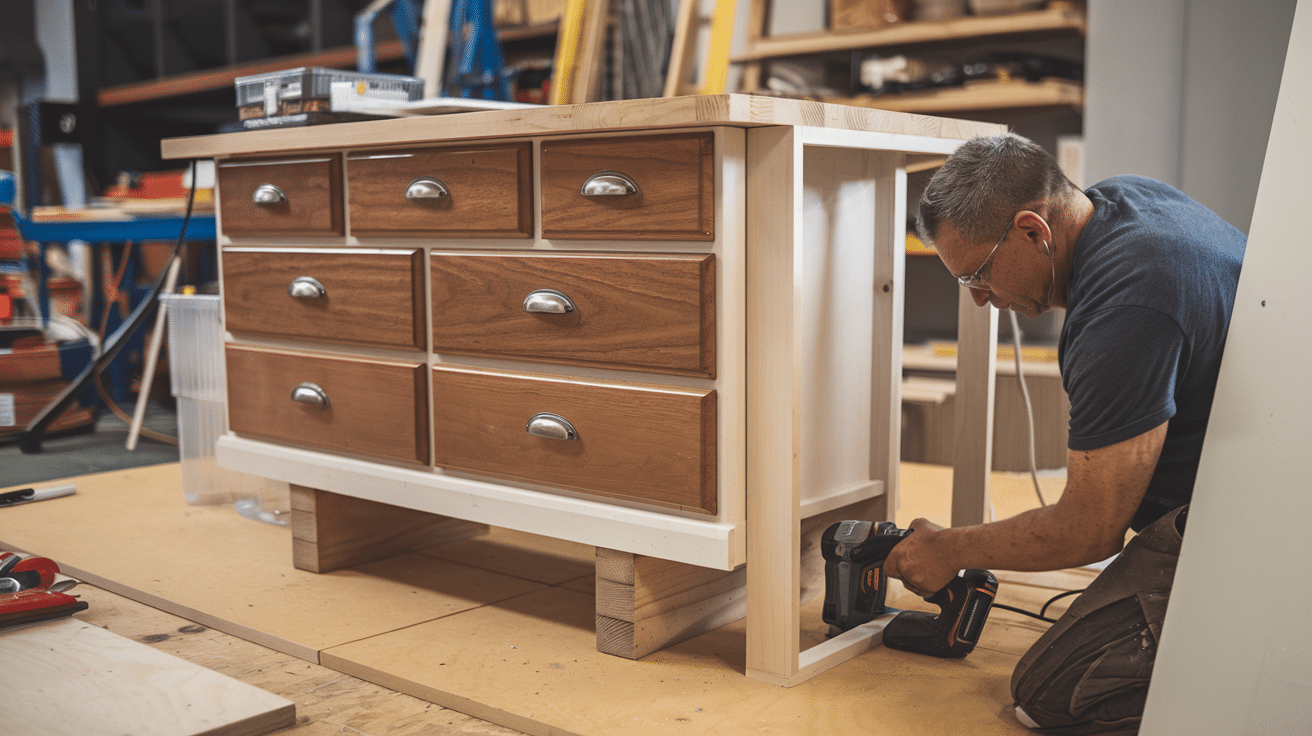Do you want to add more counter space in your kitchen without spending too much money? Old dressers can become useful kitchen islands with just a few tools and some time. Many homeowners struggle with small kitchens and limited work areas.
You can fix this problem by turning a used dresser into a kitchen island. This project costs less than buying a new island and adds both style and function to your home.
In this guide, you’ll learn how to pick the right dresser, make it the correct height, add a sturdy top, and finish it to match your kitchen. The steps are simple, and the results will make cooking and meal prep much easier.
Let’s start building your new kitchen helper!
Understanding the Basics of Repurposing Furniture
Old furniture can find new life in your home. Reusing items like dressers saves money and helps the planet. A dresser works well as a kitchen island base because it has the right shape and built-in storage.
Turning old items into new ones takes some planning, but the results are worth it. Before you start your project, consider the dresser’s size, height, and condition.
Benefits of Upcycling
- You spend less money compared to buying new kitchen items
- You keep useful items out of landfills
- Each piece has its own history and character
- You can customize the final product to fit your exact needs
- The finished item often has better quality than cheap new options
Why a Dresser is Ideal for an Island
- The drawer space offers ready-made storage for kitchen tools
- Most dressers have a solid wood frame that can support a heavy countertop
- The standard width works well for kitchen use without taking up too much floor space
- You can find dressers in many styles to match your kitchen decor
- The flat top surface creates a good base for adding a work surface
With some simple changes, that old dresser can become the center of your kitchen activities. The drawers that once held clothes will now store utensils, dish towels, and cooking tools—all within easy reach while you cook.
Tools and Materials Required
Here is the table to provide a clearer and more organized view of the tools and materials you’ll need to understand the process better.
Tools Required
| Tool | Purpose |
|---|---|
| Screwdriver | For removing hardware and attaching new parts |
| Drill | For making pilot holes and attaching hardware |
| Saw | For cutting wood pieces to size |
| Sander or Sandpaper | For smoothing surfaces before painting |
| Paintbrushes | For applying paint and finish |
| Measuring Tape | For accurate measurements |
| Level | To ensure even surfaces |
| Tack Cloths | For removing dust before painting |
Materials Required
| Material | Purpose |
|---|---|
| Used Dresser | Base structure for the island |
| Plywood | For creating a bottom surface and flip-top |
| Trim Pieces | To hide plywood edges |
| Beadboard | For backing (optional) |
| Paint | For finishing the dresser base |
| Wood Stain | For raw wood pieces |
| Polyacrylic Finish | To protect surfaces |
| Wheels | To make the island mobile |
| Hinges | For flip-top and hidden storage |
| Drawer Pulls/Handles | For drawers and towel holder |
| Hooks | For hanging items |
| Sandpaper (220 & 320 grit) | For prep and between coats |
Step-by-Step Guide to Building a Dresser Kitchen Island
Step 1: Prepare the Dresser
Start by getting the dresser ready for its new life as a kitchen island.
- Remove all drawers and their slides from the dresser body
- Take out the bottom drawer support rail to make room for the cubby space
- Look for water damage or weak spots that might need extra support
- Set aside any hardware or parts you might want to reuse later
Pro Tip: Put all screws, knobs, and small parts in labeled sandwich bags to keep track of what goes where.
Step 2: Add a Base and Support Structure
A strong foundation will make your island stable and useful for years.
- Cut plywood to match the bottom dimensions of your dresser
- Center the plywood on the bottom to create even support all around
- Use screws to attach the plywood firmly to the dresser base
- Cut and attach trim pieces to cover any raw plywood edges for a finished look
Pro Tip: Use wood glue along with screws when attaching the plywood for extra strength and stability.
Step 3: Enhance the Structure
These changes turn a simple dresser into a functional kitchen workspace.
- Replace any damaged backing with beadboard for a clean, fresh look
- Install wood supports on the inside for mounting flip-top brackets securely
- Measure and cut wood for both the cubby area and the flip-top extension
- Sand all new wood pieces and round the edges for safety and comfort
Pro Tip: Take photos before and during disassembly so you can reference how things fit together later.
Step 4: Create a Hidden Storage Space
A secret compartment adds useful storage and a fun feature to your island.
- Cut a piece of wood that fits snugly into the bottom of your cubby area
- Mark and pre-drill holes for the hinges to prevent wood splitting
- Test fit the hinges before final installation to ensure proper movement
- Allow at least 1/8 inch gap between joined pieces for smooth hinge operation
Pro Tip: Use masking tape to temporarily hold pieces in place while marking for hinges to get the most accurate alignment.
Step 5: Sand and Prep for Finishing
Good preparation leads to a professional-looking paint job that will last.
- Sand all surfaces of the dresser with 220 grit paper in the direction of the grain
- Pay extra attention to corners and edges where paint tends to chip
- Use tack cloths to wipe away all dust after sanding
- Check that all surfaces feel smooth to the touch before applying any finish
Pro Tip: Use a sanding block rather than just paper to ensure even pressure and more consistent results.
Step 6: Paint and Finish
Proper finishing protects your island from kitchen spills and daily use.
- Apply paint in thin, even coats using a high-quality brush or roller
- Allow each coat to dry completely before sanding with 320 grit paper
- Stain raw wood pieces with your chosen color, wiping off excess promptly
- Build up multiple thin coats of polyacrylic on food-adjacent surfaces for durability
Pro Tip: When applying polyacrylic, work in a dust-free area and use a foam brush for a smoother finish with fewer bubbles.
Step 7: Add Functional Hardware
Thoughtful hardware additions make your island more useful in daily cooking.
- Mark and pre-drill all holes for attaching hardware to prevent wood splitting
- Choose drawer pulls that complement your kitchen’s existing style
- Repurpose an old handle as a towel bar on one side of the island
- Add sturdy hooks for oven mitts, measuring cups, or other kitchen tools
Pro Tip: Install towel bars and hooks at heights that won’t interfere with people moving around the kitchen.
Step 8: Add Wheels and Final Assembly
Mobility makes your island more versatile in different kitchen layouts.
- Select heavy-duty locking casters rated for at least 50 pounds each
- Attach wheels to the legs securely with appropriate screws
- Test the wheel locks to make sure they hold firmly when engaged
- Check that the final height matches standard counter height (36 inches)
Pro Tip: Place felt pads between the wheels and legs to reduce stress on the wood and prevent the wheels from loosening over time.
For a visual tutorial, refer to this video by The Inexperienced Adventures
Common Mistakes to Avoid
Choosing the Wrong Dresser: Many people buy dressers that don’t fit their space or needs. Always measure your room and consider how much storage you really need before buying.
Underestimating the Work Involved: Fixing up old dressers takes more time than most people think. For best results, set aside a full weekend rather than just a few hours.
Skipping Proper Prep Work: Rushing to paint or stain without sanding or cleaning first often leads to poor, short-lived results that peel or chip quickly.
Using Low-Quality Materials: Cheap paints, thin handles, or flimsy drawer slides might save money now, but cost more when they fail and need replacement soon after.
Forgetting About Function: Pretty dressers that don’t open and close well aren’t useful. Make sure drawers slide smoothly and handles are placed for easy use.
Conclusion
Turning an old dresser into a kitchen island is a smart way to add more space in your kitchen.
This project may take time, but the results are worth it. You now have a useful spot for meal prep, storage, and even casual dining.
Remember to pick a sturdy dresser that fits your kitchen size. Take time with each step, from sanding to sealing, for the best outcome. Secure your island properly to keep it stable during use.
Your new kitchen island not only gives you more work space but also adds a unique touch to your home. The best part? You made it yourself!
Have you tried making furniture for your kitchen? Let us know in the comments about your experience or questions.

















One Comment
pin-up: pinup az – pin up casino